'Burnout is real': Student athletes' mental health is not a game
- Oops!Something went wrong.Please try again later.
- Oops!Something went wrong.Please try again later.
Sports are fun. Sports are competitive. Sports can be stressful.
That stress can motivate or demoralize student athletes – sometimes both.
“Burnout is a real thing for kids. They’ve been specializing since they were 10, and now they’re 17 and they don’t want to do it anymore,” said sports psychologist and former major-league baseball pitcher Bob Tewksbury, formerly of Concord.
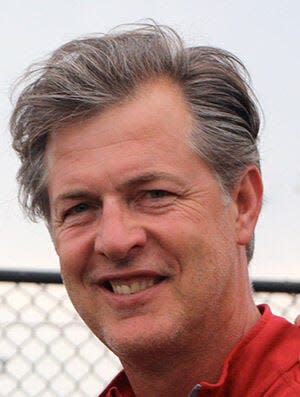
“The pressures of being a student athlete are immense. They don’t start in college. They start in high school, when they’re trying to get to college,” Tewksbury said.
The sporting world is more aware of mental health now than ever before. Gone are the days dominated by a “tough-it-out” culture.
Gymnast Simone Biles struggled at last year’s Olympics. Tennis champion Naomi Osaka has spoken openly about her mental health. So have swimmer Michael Phelps, NBA stars Kevin Love and DeMar DeRozan and former college football player Dwayne “The Rock” Johnson.
Still, troubles persist. Still, troubles persist. At least four student-athletes have committed suicide in 2022, according to CBS Sports. Mental health awareness and making resources available to student-athletes are on the minds of coaches, players, administrators and staff.
It's a sizable population. According to the New Hampshire Interscholastic Athletic Association, about 38,000 students took part in high school sports in the state last school year. U.S. Department of Education statistics say about 4,600 athletes compete at Granite State colleges and universities.
Anxiety, depression and worsen for student-athletes
Mark Hiatt, sports psychology director at Dartmouth, said the pressure starts early.
Editor's note: This is the fourth story in a year-long mental health series in a partnership between Seacoast Media Group, The Union Leader and Dartmouth Health.
“Kids are specializing earlier across all sports. Twenty to thirty years ago, there were just a few sports that had that kind of specialization,” Hiatt said. “There’s a lot of travel, there’s a lot of expense, and families are involved. Some kids do fine with it, some families do fine with it, and for some it builds over time. … It’s a lot to carry.”
The strain of competing at a high level while balancing studies and personal relationships can overwhelm young people. It did just that to Lauren Moran, a senior softball player at Saint Anselm College.
A self-described perfectionist, Moran said she put a lot of pressure on herself to succeed on the field and in the classroom. It took a toll on her.
“In high school, I started to deal with really bad anxiety,” said Moran, from Leicester, Mass. “The anxiety was so bad, I became depressed.”
The strain continued in college, and the isolation of the COVID-19 pandemic was a breaking point.
“I did try to take my own life,” she said. “I’m glad that didn’t work out.”
Moran was admitted to an inpatient mental health hospital. “It was absolutely the most amazing experience I could have had,” she said. “It was exactly what I needed."
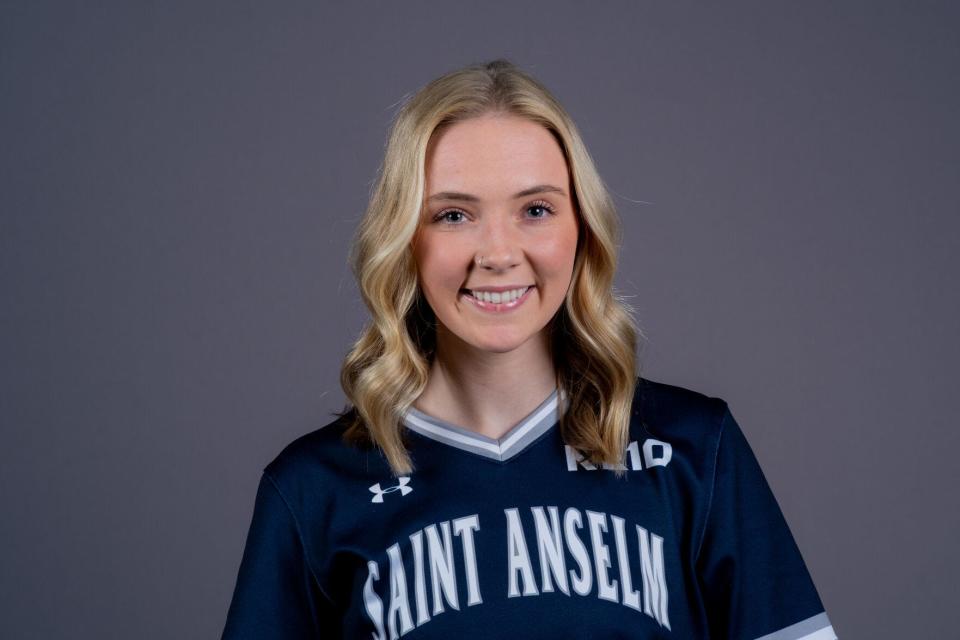
Moran, a nursing student, now uses her social media presence to talk about mental health topics. She was nervous at first about sharing her story but was flooded with messages of support and gratitude.
Her passion for mental health topics encouraged her to become part of the Head Game Project at Saint Anselm, a student-led group that works to improve mental health awareness and resources for student-athletes.
The Head Game Project created by student athletes for their peers
Now in its third year, the Head Game Project is a student-directed group that aims to make it normal for student athletes to talk about mental health.
“Athletes are projected as being tough having it all together and not showing that you can struggle. So when the Head Game Project was started, a huge reason was to be like, ‘It's OK to talk about it. We all go through things from time to time and it's OK,’” said Alyssa DeCotis, the director of sports medicine and athletic performance at Saint Anselm, who works with the students.
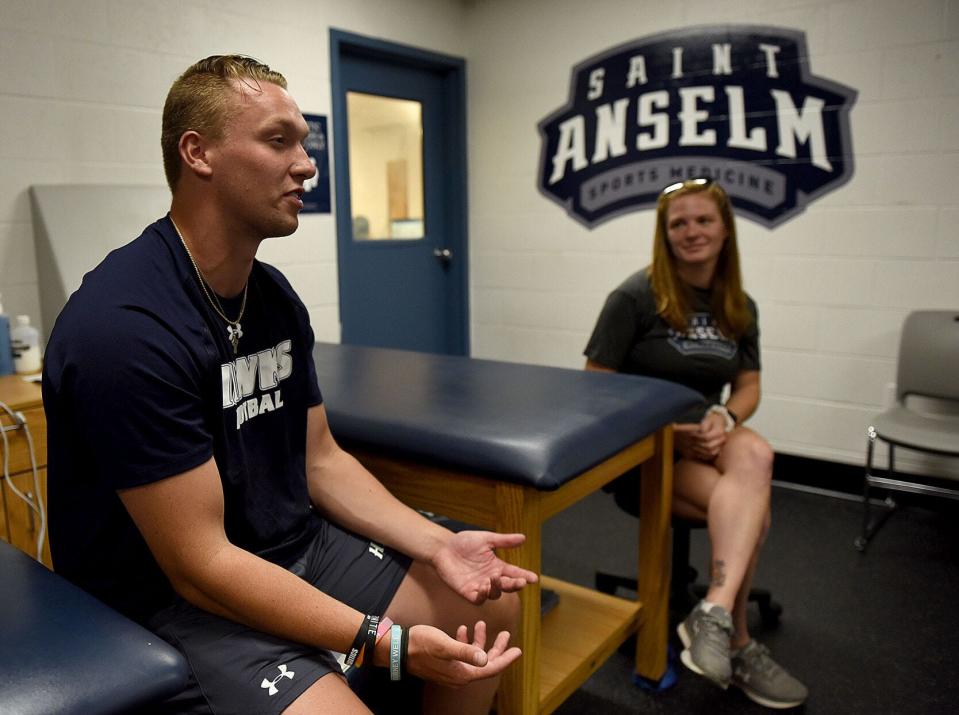
The current leaders, junior football player Cillian Davis of Plymouth, Mass., and Moran, the senior softball player, head a group of 35 representatives of the college’s 21 athletic teams that make up the project.
The team has weekly meetings during the school year and monthly virtual meetings in the summer to discuss issues athletes are having, as well as to provide resources on mental health, nutrition, sleep, education and other timely matters.
Davis said anxiety and depression are the two most common issues student athletes face. He said both are tied to burnout, “which is right now the biggest issue for collegiate athletes."
"I feel like you're doing it literally, if you want to, 12 months out of the year, and there's really no break.”
'Drive to excel': The pressure can be too much
The pressure to succeed that is placed on young people – and they place on themselves – can be too much, said Susan Stearns, executive director of the National Alliance on Mental Illness-New Hampshire.
“We do see in the literature about the pressures that we put on young people that early on – the pressure to figure it out, choose your path,” she said. “We’re asking a 16-year-old, ‘What do you want to do with your entire life? Go study that,’" she said.
“Societally we have put on young people this drive to excel.”
Hyper-specializing in just one sport at an early age can deprive a young person of critical growth opportunities, Stearns said.

“If you push someone at this young age, ‘This is my sport, this is my area of expertise,’ there are the opportunities they miss out on,” she said. “When you play sports seasonally, you change. All of those are good life skills to develop. Teams change, and you work with new people.”
Tewksbury, who worked as a sports psychologist for the Boston Red Sox, San Francisco Giants and Chicago Cubs from 2004 to 2020 and now does private coaching from his home in Wells, Maine, said the pressure on student-athletes tends to be greater than on other students.
“The student-athlete has to prioritize time and train and eat and still get their school work done. I think there’s a lot more stress on them than the regular student who has ample time to do their (school) work and more choices of free-time activity,” he said.
Athletes specializing in one sport too soon
Tewksbury said he works with a 19-year-old figure skater who has been competitive in her sport since she was 10.
“Homeschooled. At the rink four or five hours a day. She’s been on the women’s national team a couple times, and she’s tired of skating. She wants to have a life. She wants to go to college. She wants to have friends,” he said. “It’s a really challenging world now for student athletes.”
Cultural changes have a role in the increased pressure, Tewksbury said. Once upon a time, kids played multiple sports and didn’t specialize until high school or even college.
Years ago, “you wouldn’t think of playing a single sport year-round – from a baseball perspective and I’ll bet even from an orthopedic perspective,” Tewksbury said. “The increase in injuries of the young athletes now is from overuse.”
Colleges respond to help athletes' mental health
Colleges and universities have responded to the increased awareness of mental health issues among student-athletes by forging strong links between athletic departments and campus mental health counseling resources.
Dartmouth created the Dartmouth Peak Performance program in 2011, which sports psychologist Hiatt said involves sports medicine, athletic training, strength and conditioning, nutrition, leadership and mental performance, as well as academic support.
“We all meet weekly and do a lot of cross-programming and education with the students,” he said.
Students also created their own resources. Dartmouth has a chapter of Morgan’s Message, a program started at Duke University that emphasizes the mental health of student athletes. Dartmouth students founded a group called The Hidden Opponent, as well as one called the Sideline Perspective for injured athletes. Saint Anselm launched its Head Game Project.
Hiatt said the University of Michigan was one of the first to create a program to connect athletes over mental health topics, and many other schools have done some similar things.
The National Collegiate Athletic Association in 2014-15 published a book called “Mind, Body and Sport,” and began to get more involved in mental health topics. Now, the NCAA runs training programs for all coaches about mental health awareness.
Sources of stress for athletes
Hiatt said student athletes at Dartmouth frequently were captains of high school teams and at times have to accept new, lesser roles on their college teams. That can be a challenge to their identity, he said.

Fear of injury is another source of anxiety for student-athletes, Hiatt said. Athletes want to play and are concerned about losing their place in a team. Concussions, he said, are of particular concern.
“There’s a lot of stress around the injury and the recovery process. Some injuries there’s a set recovery process, and some can be very uncertain, particularly concussions,” Hiatt said. “For college students and high school students, if you’re concussed, you rest your brain and they’re working, they’re studying, they’re in front of screens, which can prolong the process.”
Another challenge is helping students adapt to the end of their athletic careers, which for most coincides with the end of college.
“It’s been a big part of their identity,” Hiatt said. Counselors work with students to ask, “How else do I start to define myself outside of my sport?”
UNH football coach Sean McDonnell created a liaison position between coach and players
Retired University of New Hampshire football coach Sean McDonnell said the emphasis on mental health in his program began 20 years ago, when then-athletic director Marty Scarano asked UNH faculty member Tim Churchard, who played Wildcat football and hockey as a student, to be a liaison between the football players and coaches.
“Tim actually became a buffer between the coaches, the players,” McDonnell said. “He would observe practices, he would watch kids’ body language. They would open up a lot more to him than they did to the head coach, the position coach."
“I thought it worked really well,” he said. “It was really an eye-opener for me because we had never had things like that before in my program.”
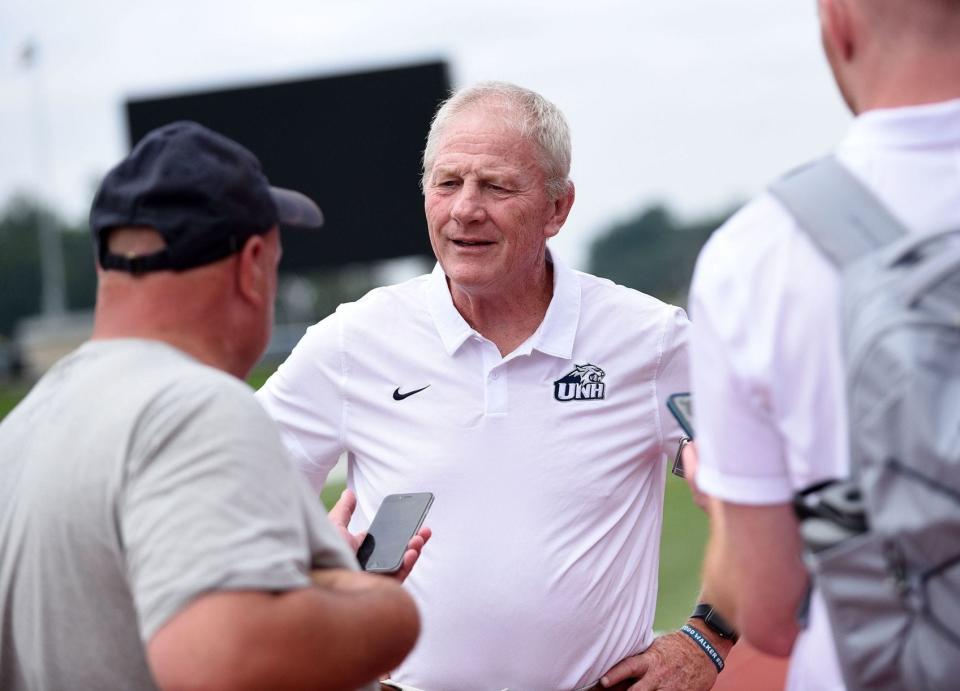
McDonnell told the story of one player, a three-year starter, who had a terrible fall camp his senior year. Churchard helped get to the bottom of things.
“His brother was over in Afghanistan, and he hadn’t heard from him in three or four days,” McDonnell said, and the player was in distress because of it. “He opened up to me, and were were able to work through the situation, to get some communication going between him and the coaches, and the position coach.”
“Those are things you just never encountered or thought of when you were doing this, when you first started,” he said.
High schoolers get the blues
High schools don’t have the breadth of resources that colleges do. NAMI’s Stearns said her organization has fielded a number of requests from high schools to support student-athletes.
“We have responded to some of those with training for staff, including athletics’ staff, and training for those youth leaders,” she said. “Right now we continue to hear from our school partners across the board about the struggles youth and young adults are having.
“Understandably, athletics personnel are really concerned about their students’ well-being. It’s been a challenging time for folks, and the past few years have been even more challenging” because of the COVID pandemic, she said.
Rob Grabill, longtime boys soccer coach at Hanover High School and an ordained Church of Christ minister, said the job of a high school coach has become a lot bigger in recent years.
“Coaches and educators are being asked to do more,” he said. “Schools are feeding kids more. Teachers are becoming social workers.”
“It used to be that all the coaches were in the school, teachers coach,” he said, and that would help a coach know what was going on in school with students. That presence with students, he says, makes a difference.
“Now you’ve got a lot of people who are paid to coach, spend a lot of time and invest a lot, build good team culture, they may or may not be in the building.”
Same goals, new approach
UNH's McDonnell said becoming more aware of student mental health didn’t change how his coaches coached.
“We still coached hard. We still asked a lot of them. We gave great examples for how (their coaching) worked with other kids, great examples of other teams, “ he said. "Senior players still led younger players on how to grow as a player."
But mental health awareness, McDonnell said, “was a whole new world."
"You would become very alert, not just on the practice field or in the weight room, but also his habits of, how is he in the classroom. Who is he hanging around with?," McDonnell said. “Talking to his friends, is something going on with him? I’m getting a vibe that something might be going on."
"The kids are aware of this now. Most of the kids who are leaders in your program, they’ll be honest with you because they want to help these kids,” McDonnell said.
The problems student athletes are dealing with haven’t changed much in the past few decades, McDonnell said.
But, he said, “I think we’re more fully aware of how deep some of these things are, the effect that it has on a kid, performance in the classroom, performance on the field,” he said.
Seeking healthy balance
Hiatt said Dartmouth coaches want to be more involved in supporting student mental health, and the school is eager to help coaches. This year, it's offering a mental health first aid program.
“Coaches deal with their own pressures,” he said. “We don’t expect coaches to be therapists, though sometimes it can feel like they’re in that role, but they have the confidence of (athletes), they get to know these athletes well.
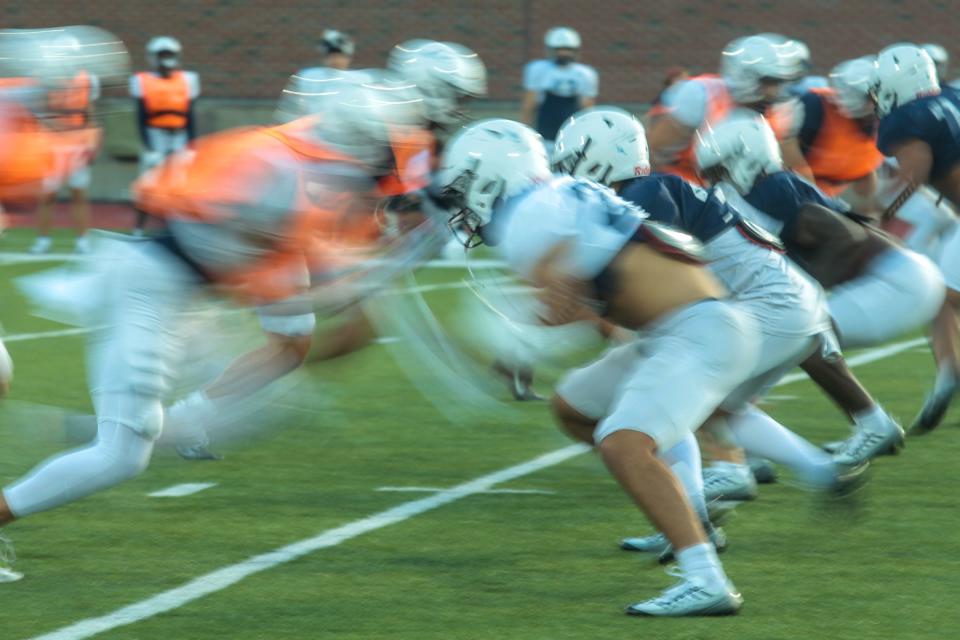
"If they’re starting to see signs that their students are struggling or withdrawn, they can respond and be supporting and help the student get directed to the appropriate resources.”
McDonnell said mental health awareness has been on the minds of coaches nationwide for years. One of his proteges, Ohio State football coach Ryan Day, who grew up in Manchester, devotes a lot of time to suicide prevention.
Another of his former assistants, Manchester product Chip Kelly, now coach at UCLA, also successfully walks the tightrope between winning on the field while being in tune with his students’ mental health needs.
“I’m fortunate to watch how they handled situations like this, and they’re able to find that balance to be successful, and that pressure of winning at all costs is not the deal,” he said. “You’re not going to sacrifice some kid’s life or his journey because you’ve got to win football games."
Athletics can do young people a lot of good, Hanover coach Grabill said, but only if kept in proper perspective.
“Athletes who are in training can be better rested, and enjoy all of the positive results from following a schedule, eating a more healthy diet, and reducing stress,” he said. “However, burnout is a danger if an athlete goes down the rabbit hole of prioritizing sports at the expense of balance in their lives."
Help support quality local journalism like this.
"Youth sports pose a real risk of dominating a student's life, especially if parents have an unrealistic expectation of what can be gained," Grabill said. “Yet sports continue to have the potential to help and heal youth whose lives have become filled with stress and unhealthy habits.
"Proportional participation in sports should be the cure, not the cause of burnout.”
Said Tewksbury, "Preventing burnout is pretty easy, but due to the overlapping seasons in youth sport now, it's also very challenging."
He recommended not playing multiple sports at the same time, not playing one sport all year long, and building in rest and recovery, including no sports or training at all for an extended period of time.
Doing a lot of good
Experts say it’s important to remember that participation in sports brings a lot of positives, certainly to physical health, but also in many cases to mental health.
“The protective factors students get from playing sports, interaction with other students and interaction with caring adults” are all critical to a young person’s development, NAMI’s Stearns said. “Those adults play critical roles in the student support network.”
“Sports is a wonderful avenue for learning, for fun, for connection with peers,” Dartmouth’s Hiatt said. “That’s one thing that time and time again the athletes will talk about, their connections with teammates.
"And it should be fun. Sports changes as you get into a collegiate environment, but it should have that core element of having fun.”
Grabill credited sports with helping young people come back from the COVID pandemic.
“I think sports really helped normalize kids for coming back to school,” he said, noting that other extracurricular activities did, too. “I think it’s very clear that sports in general and high school sports in particular have done a lot to keep kids on an even keel.”
Read more of the series
mmcsorley@unionleader.com
This article originally appeared on Portsmouth Herald: Student athletes' mental health a growing concern. Here's what to do

